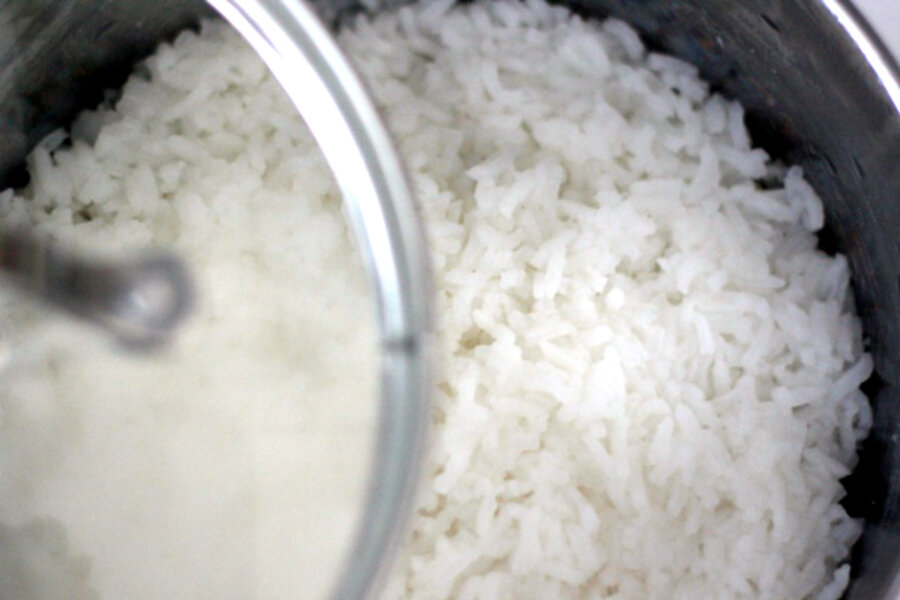How to cook rice: 3 ways
Loading...
People who cook rice at home often belong to one of two camps: those who cook their rice in a rice cooker, and those who cook it on the stove top.
When I was in the beginning stages of researching my cookbook, The Asian Grandmothers Cookbook, I met a woman who was adamant that I should include a recipe for cooking rice the “right” way on the stove. I smiled and told her sweetly, “I use a rice cooker.”
Then, last year, during our multi-pronged move from Seattle to Washington D.C., I had to survive four whole months without my beloved rice cooker.
In those few months, with only two pots to my name, I had no choice but to learn how to cook rice on the stove. I even attempted microwave cooking as well! Through trial and error, I perfected cooking rice using three methods, no special equipment necessary.
I realize now how spoiled I’ve been by my rice cooker – all I had to do was rinse, add water, and push a button. It was a humbling experience learning to cook without one of my most-used kitchen gadgets. Not to mention, I’m very surprised how much tweaking a seemingly simple food requires to achieve perfection.
Needless to say, if I met that woman again, I’d have to put my foot in my mouth.
Note: I used jasmine rice for all these recipes but you can use any type of rice you prefer. You just have to adjust cooking times and the amount of water accordingly. For example, brown rice requires more water and a longer cooking time. The rice package should give you guidelines.
1. Stovetop Absorption Method
This method can be tricky, as the ratio of rice to water varies depending on how old the rice is. The older the rice, the drier it is, and the more water you’ll need for it to come out tender. As a general rule, new-crop rice uses a one-to-one ratio, but older rice needs 1 cup rice to 1-1/4 cups water. New crop rice is usually labeled as such on the bag. Regardless, always pay attention to the rice-to-water ratio the first time you make rice from a new bag, even if it is your favorite brand that you’ve been buying for decades. If the rice is too dry, add more water, a few tablespoons at a time, and continue cooking. If it’s too soggy, decrease the water gradually the next few times you cook. You may have to make a few mediocre pots before you get perfect rice, but it will be worth it! Look for Thai or North American jasmine rice – they are of the highest quality.
Time: 40 minutes (10 minutes active)
Makes: 2 to 3 servings
1 cup jasmine long-grain rice, rinsed until the water runs almost clear
1-1/4 cups water
1. Combine the rice and water in a medium heavy-bottomed saucepan with a tight-fitting lid (preferably glass so you can observe the changes). Set the saucepan over high heat and bring the water to a simmer. Bubbles will gather around the edge of the saucepan. Reduce the heat to the lowest possible setting and cover the saucepan tightly with the lid. Cook for 15 to 18 minutes, or until all the water is absorbed.
2. Turn off the heat and let the rice steam, lid intact, for another 10 minutes.
3. Lift the lid and gently fluff the rice with a fork or a pair of chopsticks. The rice should not be lumpy and the individual kernels should be separate.
4. Keep the rice covered until ready to serve. Serve hot.
2. Stove top Pasta Method
Just as the title suggests, you can cook rice the same way you cook pasta. I don’t measure the water, I just fill my pot up with just enough water so that it won’t boil over. I love how the rice grains come out plumper and fluffier, and the kitchen rebel in me likes that precision isn’t key. My friend swears by this method for cooking brown rice – she claims it only takes 30 minutes and the rice comes out perfect every time.
Time: 20 minutes (5 minutes active)
Makes: 2 to 3 servings
1 cup jasmine long-grain rice, rinsed until the water runs almost clear
Water
1. Pour in enough water to reach about 3/4 up the sides of a 4- to 6-quart pot and add the rice. Bring to a boil. Turn the heat down until the water simmers sprightly but isn’t boiling over and cook uncovered. Stir when you remember.
2. Start testing the rice at around 15 minutes. When the rice is cooked to your liking, turn off the heat and strain in a colander over the sink. Serve immediately.
3. Microwave Method
The best vessel to cook rice in the microwave is the tallest one that can fit in your microwave as the contents tend to overflow making a huge mess. You can buy one here. I’ve tinkered with this recipe a little and I’ve found that a large, wide vessel with straight sides works well. (I used a 2-1/2 quart Corningware casserole dish.) But, you can’t cook too much rice at one time, and you have to cook it on very low. All microwaves are different (and depending on the rice you use) so you’ll probably have to use trial and error to get this right, but don’t be discouraged!
Time: 20 minutes (5 minutes active)
Makes: 2 to 3 servings
1 cup jasmine long-grain rice, rinsed until the water runs almost clear
1-1/2 cups water
1. Combine the rice and water in a microwave-safe container.
2. Cover and cook in your microwave on low (I put mine to 60 percent) for 20 minutes. Check every 5 minutes and stir.
3. Once the rice is cooked to your liking, leave the lid on for about 5 minutes, then fluff with a fork and serve.








